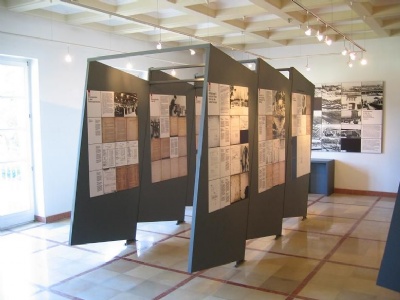Inspectorate for KZ
In the aftermath of the Reichstag fire in February 1933, thousands of political opponents of the nazis were arrested. These opponents were put in Protective Custody or so-called wild concentration camps that temporarily served as prisons. They were set up in empty premises and operated by local SA units without any centralized control. To solve this, the head of the SS, Heinrich Himmler, established in December 1934, a central authority called the Inspectorate of KL (concentration camp) with the purpose of centrally controlling and administering the concentration camps. All former wild and de-centralized concentration camps were liquidated. The inspectorate’s first commander was Dachau’s commandant, Theodore Eicke, a hard-line Nazi who at Dachau had laid the foundation for the concentration camp system. The inspecorate’s main office was located at Prinz Albrecht Strasse in Berlin.
In 1938, the Inspectorate moved to a T-shaped building near the Sachsenhausen concentration camp, in Oranienburg, north of Berlin. The building was built between 1937 and 1938 by prisoners from Sachsenhausen. In the main office surroundings there were built exclusive villas for inspectorate employees and their families. The exception was Theodore Eicke, who had his villa built just outside the SS settlement area. About 100 SS officers worked within the inspectorate to plan, administer and instruct camp commanders how the camps would be run and what was expected of them. The inspectorate also conducted education courses for future commanders and others who would serve in the concentration camp system. The inspectorate also handled the camp’s economy, including pay roll for the camp staff. Each camp sent regular reports to the inspectorate. These reports also included the number of prisoners killed, including mass murders of Jews. The inspectorate also conducted regular visits to the concentration camps to follow up their directives. Sometimes the camp Commandant requested av visit from the inspectoraste, sometimes the inspectorate paid visits out of a tip that something was wrong.
In 1939, Theodore Eicke was appointed commander of the newly formed SS armed division, Totenkopf. A division that partly consisted of guards from the concentration camps. Eicke’s replacement was SS-Gruppenführer, Richard Glücks. In 1942 the inspectorate was moved to SS Main Economic and Administrative Office (SS-Wirtschafts - und Verwaltungshauptamt) and named department (AMT) D. The reason was that prisoners had in large numbers begun to be hired out as slave labor to war-producing industries. Auschwitz’s first commandant, Rudolf Höss, was in December 1943 appointed head of department D I (central office), a subdivision of department D. Shortly after the war, Richard Glücks committed suicide. Theodore Eicke was killed in February 1943 when his plane was shot down by Soviet flak in Ukraine. Rudolf Höss was sentenced to death by a Polish court after the war and hanged in Auschwitz, 1947.
Current status: Preserved with museum (2008).
Address: Heinrich Grüber platz, 16515 Oranienburg.
Get there: Car.
Follow up in books: Kogon, Eugen: The Theory and Practice of Hell: The German Concentration Camps and the System Behind Them (2006).


The exhibition is in German and there is no English translation. Of the original interior there is nothing left because this was removed by the Soviet Union. This is unfortunate because the rooms are now only furnished with information boards which gives a sterile impression. Outside the inspectorate there are villas that the officers of the inspectorate lived with their families. In 2008 these are private villas.